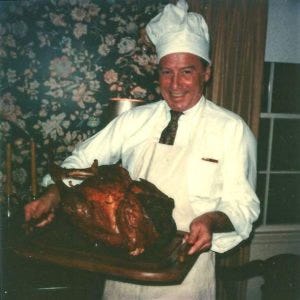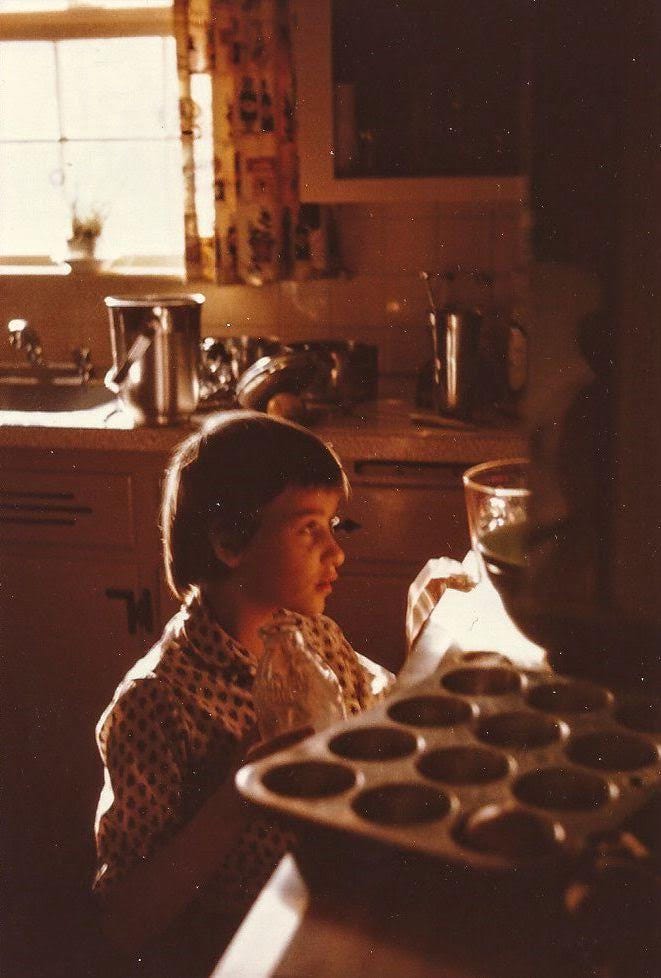How do you express your love? Some people rely on a Valentine’s dinner, or reveal their feelings with a supportive word and a tender embrace. Others show their affection by cooking a meal for those they care about. My favorite—an effective metaphor—is often the latter.
During my childhood, love was often overshadowed by my mother’s mental illness. Every day, my father tried to combat that darkness by coming home from work, stripping off his jacket and tie, and setting saucepans out on the stove. Unlike today, it was unusual for a man to don an apron, but Dad had resolved to create a happy family dinner table–something he hoped would give my sister and me the stability we needed so badly in the wake of my mother’s ups and downs.
His food was always simple, whatever he could manage between five and six o’clock. Unfortunately, once we all sat down, his effort was often swamped by tension. Love crept out of sight: my mother sometimes refused to eat at all, and Dad grew silent and angry. None of it was anyone’s fault. It was just the way it was.
Over time, I became interested in cooking with Dad, and he passed along his family recipes, complete with secret tips. I learned how to slow bake a chicken slathered in butter, or put together a tasty spaghetti sauce infused with garlic, or simmer beef stew till the house became redolent with the fragrances of marjoram and thyme.
By the time I was in high school, we were discovering together the joy of new recipes for increasingly elaborate foods, as we both grew more adept: oven-baked chicken morphed into Chicken Cordon Bleu, and soon there was an Al Sexton’s Never Fail Hollandaise sauce for the Eggs Benedict listed today on so many upscale brunch menus.
See AL SEXTON’S NEVER FAIL HOLLANDAISE recipe below!
When I had my sons, I became determined–perhaps unconsciously–to rewrite the history of those past childhood dinnertimes so filled with tension. Everything I made was a way of honoring my father and the emotional security he’d tried so hard to give my sister and me, symbolically, by cooking a good meal.
I made Dad’s old recipes, but also tackled the newer and more sophisticated ones that the 90’s introduced, with its fresh approach to home cooking. Goat cheese and Niçoise olives became familiar ingredients, and my kids learned to like Chicken Marbella and rotini Bolognese. In addition to bringing love, I was also having an adventure. Even with Dad no longer by my side, it was fun! Cooking is no different for me today, though it often prods me to remember those early days at the stove with him.
Once the children were of school age and out of their high chairs, the dinner table became a place of peace, conversation and connection. The round oak table drew us close after our hectic daily schedules were complete. I had triumphed over dinnertime silence. I cherished those meals together, and it appeared the feeling was mutual. Nicholas learned how to cook by my side, and early on always made the fresh ground coffee that Jim and I guzzled down at breakfast.
The kids always said: “Thank you, Mom! This is really good!”–even if my culinary experiment had failed. Their appreciation buoyed me as I tackled the chore of supermarket runs, or peeling heaps of potatoes for latkes, or putting everyone’s favorite cinnamon applesauce through the food mill. As the years passed, my happiness helped me, at least in part, to believe I was a “good enough” mother.
A number of years ago, my son and his fiancé, now his wife, asked me to teach them how to make the meatloaf Dad invented, as well as the egg twist challah I’d begun baking on my own when I converted to Judaism some fifty years ago. Occasionally, the two of them sent me a text with a photo of the meatloaf they had shaped so carefully. These days, at the tender age of five, Nicholas’s younger son stands on a stool to help Dad cook pancakes at the stove, or to work with Mom to make a cheese omelet. Soon he will be graduating to a knife.
To me, looking at Nicholas’ photos back then was a reward. Now my reward comes in the form of a little sous chef, raised courtesy of Nicholas and his wife. It’s a reward for those years of hovering over the stove when my kids were little and ensuring that the pot roast would be tender, as well as an affirmation of the love my father passed along during those years when we cooked side-by-side so companionably. A third generation has been touched by the legacy he and I created together. And so I say: “Thanks, Dad.” And to my son, my message is clear: “Please pay it forward.” That’s all any of us can ask–that the love be handed down.
AL SEXTON’S NEVER FAIL HOLLANDAISE
Place in Electric Blender:
4 eggs yolks at room temperature
¼ teaspoon salt
Dash of Tabasco
2 teaspoons lemon juice
Blend everything at high speed.
Meanwhile, melt 1 stick salted butter in saucepan. When hot and bubbling, (but not turning brown), pour slowly into running blender.
It will thicken right away. Serve immediately.
N.B. If you need to increase recipe, do so in individual batches, keeping the previous one warm in a double boiler or a small pan within a larger pan that is set into warm water. Then combine the batches. Doing two at a time all at once will clog (and ruin) your blender!






Wonderful to hear from y ou again, Maud! I am so happy you liked this post. I think I will see it now as one of my favorites. I love the idea that you wanted to cook a meal for your family after reading it. Inspiration a la Al Sexton!
Soon your grandson will be making your dad’s meatloaf. He left your family a legacy of love and care. I think it’s a satisfying meal, as much as sleep, that knits up the raveled sleeve of care.